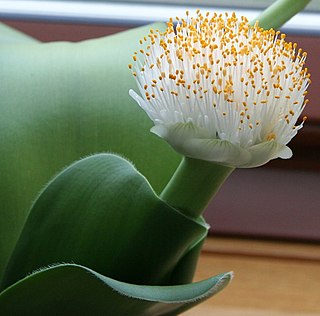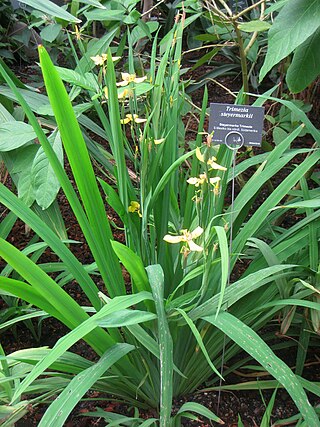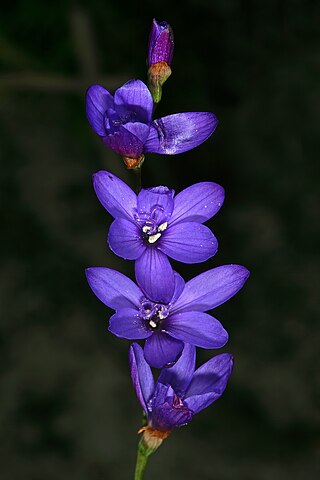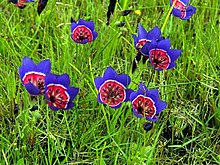
In taxonomy, binomial nomenclature, also called binary nomenclature, is a formal system of naming species of living things by giving each a name composed of two parts, both of which use Latin grammatical forms, although they can be based on words from other languages. Such a name is called a binomial name, a binomen, binominal name, or a scientific name; more informally it is also historically called a Latin name. In the ICZN, the system is also called binominal nomenclature, "binomi'N'al" with an "N" before the "al", which is not a typographic error, meaning "two-name naming system".

Bulbophyllum is a genus of mostly epiphytic and lithophytic orchids in the family Orchidaceae. It is the largest genus in the orchid family and one of the largest genera of flowering plants with more than 2,000 species, exceeded in number only by Astragalus. These orchids are found in diverse habitats throughout most of the warmer parts of the world including Africa, southern Asia, Latin America, the West Indies, and various islands in the Indian and Pacific Oceans. Orchids in this genus have thread-like or fibrous roots that creep over the surface of trees or rocks or hang from branches. The stem is divided into a rhizome and a pseudobulb, a feature that distinguished this genus from Dendrobium. There is usually only a single leaf at the top of the pseudobulb and from one to many flowers are arranged along an unbranched flowering stem that arises from the base of the pseudobulb. Several attempts have been made to separate Bulbophyllum into smaller genera, but most have not been accepted by the World Checklist of Selected Plant Families.

Dendrobium is a genus of mostly epiphytic and lithophytic orchids in the family Orchidaceae. It is a very large genus, containing more than 1,800 species that are found in diverse habitats throughout much of south, east and southeast Asia, including China, Japan, India, the Philippines, Indonesia, Australia, New Guinea, Vietnam and many of the islands of the Pacific. Orchids in this genus have roots that creep over the surface of trees or rocks, rarely having their roots in soil. Up to six leaves develop in a tuft at the tip of a shoot and from one to a large number of flowers are arranged along an unbranched flowering stem. Several attempts have been made to separate Dendrobium into smaller genera, but most have not been accepted by the World Checklist of Selected Plant Families.

Iridaceae is a family of plants in order Asparagales, taking its name from the irises. It has a nearly global distribution, with 69 accepted genera with a total of c. 2500 species. It includes a number of economically important cultivated plants, such as species of Freesia, Gladiolus, and Crocus, as well as the crop saffron.

Hyacinthus is a small genus of bulbous herbs, spring-blooming perennials. They are fragrant flowering plants in the family Asparagaceae, subfamily Scilloideae and are commonly called hyacinths. The genus is native predominantly to the Eastern Mediterranean region and Afrotropical realm, although naturalized more widely.

In biology, a type is a particular specimen of an organism to which the scientific name of that organism is formally associated. In other words, a type is an example that serves to anchor or centralizes the defining features of that particular taxon. In older usage, a type was a taxon rather than a specimen.

Prasophyllum, commonly known as leek orchids, is a genus of about 140 species of flowering plants in the orchid family, Orchidaceae and is found in Australia and New Zealand. The Australian species are found in all states but have not been recorded in the Northern Territory. The common name arises from their having a hollow, leek- or onion-like leaf. Some species only flower after summer fires and have flowers similar to those of Xanthorrhoea which flower at the same time, suggesting that they employ the same pollinating insects. Leek orchids are similar to those in the genus Genoplesium except that the free part of the leaf is cylindrical and the labellum has a solid connection to the column. They range in size from the little laughing leek orchid at about 15 cm (6 in) to the king leek orchid which grows up to 2 m (80 in) tall.

Ixiolirion is a genus of flowering plants native to central and southwest Asia, first described as a genus in 1821. Recent classifications place the group in the monogeneric family Ixioliriaceae in the order Asparagales of the monocots. In earlier systems of classification, it was usually placed in the family Amaryllidaceae.

Habenaria, commonly called rein orchids or bog orchids, is a widely distributed genus of orchids in the tribe Orchideae. About 880 species of Habenaria have been formally described. They are native to every continent except Antarctica, growing in both tropical and subtropical zones.

Haemanthus is a Southern African genus of flowering plants in the family Amaryllidaceae, subfamily Amaryllidoideae. Members of the genus are known as blood lily and paintbrush lily. There are some 22 known species, native to South Africa, Botswana, Namibia, Lesotho and Eswatini. About 15 species occur in the winter rainfall region of Namaqualand and the Western Cape, the remainder being found in the summer rainfall region, with one species Haemanthus albiflos occurring in both regions.

Ammandra is a monotypic genus of flowering plants in the palm family found in Colombia and Ecuador, where it is endangered. The sole species is Ammandra decasperma, although another species name has been proposed. It is a pinnate-leaved, dioecious palm whose seeds and petioles are used in button and basket making, respectively. It is commonly called ivory palm or cabecita.

Crocoideae is one of the major subfamilies in the family Iridaceae.

Melasphaerula is a genus of flowering plants in the family Iridaceae, first described as a genus in 1803. There is only one known species, Melasphaerula graminea, native to Namibia and the Cape Province in South Africa.

Trimezia is a genus of flowering plants in the family Iridaceae, native to the warmer parts of southern Mexico, Central America, South America, Florida, and the West Indies. Trimezia is placed in the tribe Trimezieae. The division of the tribe into genera has varied considerably. In one approach, it contains only the genus Trimezia, which then includes the genera Neomarica, Pseudotrimezia and Pseudiris. In other approaches, two to five genera are recognized, sometimes also including the genus Deluciris.
Carl Ernst August Weihe (1779–1834) was a German botanist and physician.

Geissorhiza radians or winecup flower is a highly threatened species from the Iris family with fewer than 10 remaining sub-populations growing in south-western Cape Town, South Africa. The deep purple flowers with large, red centres grow is dense colonies which makes for a spectacular flower displays from mid-September, particularly around the town of Darling. Its seasonally wet lowlands habitat is however becoming increasingly threatened with more than 80% of its original habitat now permanently transformed into agriculture or urban sprawl and the remaining populations threatened by encroaching invasive alien vegetation and fertilizer runoff. The dark-centred flowers aim to attract specific pollinators from the horsefly family (Tabanidae), but the specific interactions still require additional investigation. Each plant has 1 to 6 flowers. It is also found in smaller patches through to Gordon's Bay. The plants nearly always occur in seasonally moist wetlands which become dry in the summer months.

Geissorhiza ovata is a species of flowering plant in the family Iridaceae. It is found growing on stone ridges and rock outcrops in the Northern Cape Province of South Africa.

Geissorhiza aspera, also known as the blue satin flower or blou sysie, is a geophyte from South Africa.

Geissorhiza melanthera is a small perennial plant of 14–18 cm high that is assigned to the family Iridaceae. It survives the dry southern summer through storage of its resources in a corm. The stem carries two or three erect, sticky leaves of up to 18 cm (7 in) long, H-shaped in cross-section. This species blooms with six to twelve bilaterally symmetrical flowers, in a spike. Sometimes the spike has one side branch with fewer flowers. Each flower has six pale beige perianth lobes, a purple-red ring around a purple red tube and three blackish stamens. Each flower is subtended by two 1.25–2.25 cm long green bracts. This species flowers from the end of September till mid October. It is an endemic of the western slopes of the Piketberg mountains in the Western Cape province of South Africa.


















